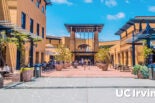Healthcare in the United States continues to undergo a tremendous transformation, including changes in the way we treat patients, the way reimbursement works, and the consumerization of healthcare through the use of digital technology.
At UC – where part of mission is tied to practice, research, and teaching in healthcare – we must find innovative ways to respond to these changes and stay competitive both as a patient-preferred provider and a cost-conscious deliverer of care. UC Health – which is the umbrella organization for the five academic medical centers (UCD, UCI, UCLA, UCSD, UCSF), and 17 health professional schools – examines these challenges and drives strategy at a biannual leadership retreat.
At the November 5 – 6 retreat in San Diego, a major topic was the medical centers’ initiative to operate more as a single health system, leveraging the scale of the UC health care enterprise to reduce costs and achieve greater value. The five health system CIOs own a work stream in this initiative and have developed a close working relationship to drive value.
The CIOs recently unveiled their first UC Health-wide strategy – the adoption of a north-south strategy for data centers in the UC Health enterprise. A contract with Dell has been signed for data center space in Quincy, WA, along with the expanded use of the San Diego Supercomputer Center. This will enable UC Health to not only consolidate its data center footprint but also share infrastructure to achieve significant cost savings. Migration of services from local data centers to the single UC Health data center will begin in early 2016.
Dr. Atul Butte (spotlighted recently in this blog) and I provided an update on an initiative to aggregate UC clinical data for research and quality improvement purposes. This initiative has gained a lot of support from across the UC health and life science community and also links to President Obama’s State of the Union Address message around precision medicine. UC is the point organization on precision medicine for California’s governor.
All this speaks to technology having a greater impact in helping UC find solutions to the challenges in healthcare, whether through enabling synergies and efficiencies or by making data available to inform decisions and outcomes. And this means CIOs and their IT teams are at the center of strategic conversations.
UCSF CIO Joe Bengfort spoke eloquently about the collective efforts to work together to manage our IT investments and lower costs over time.
UCD CIO Mike Minear described how the chairs of the Departments of Radiology have made a conscious decision to implement a common solution to manage radiology orders that complies with new legislation around appropriateness of imaging procedures.
The new CIO of UCSD Health, Chris Longhurst, his first week on the job, joined the discussion among chancellors, deans, CIOs, and CEOs about collaboration in action. He said, “It’s awesome to see the UCs acting as a system to better care for all Californians. It has been said that the rocket science of healthcare is how we deliver it, and University of California is well positioned for the moonshot.”







